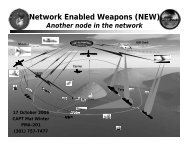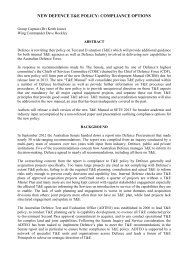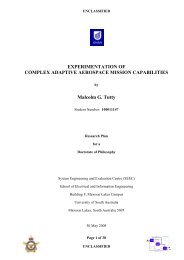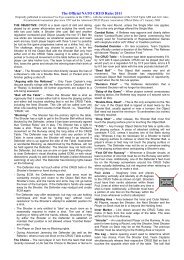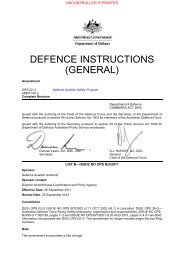MIL-HDBK-244A 6 apr 90.pdf
MIL-HDBK-244A 6 apr 90.pdf
MIL-HDBK-244A 6 apr 90.pdf
You also want an ePaper? Increase the reach of your titles
YUMPU automatically turns print PDFs into web optimized ePapers that Google loves.
<strong>MIL</strong>-<strong>HDBK</strong>-<strong>244A</strong><br />
4.2.2 Tv~e II. Type II presents a cha” lenge to the aircraft and<br />
suspension equipment designers and represents the most complex problems. The<br />
stores to be carried on a particular aircraft can and do, have a profound<br />
effect on the specific aircraft design and quite often are the cause of aircraft<br />
design trade-off.<br />
4.2.3 Tvpe III. Type III places a large portion of the responsibility<br />
and effort for achieving compatibilityon the.store designer. It is<br />
not uncommon to find that the requirement for carriage of a newly developed<br />
store on certain specific aircraft has had a major influence on the store<br />
design. The aircraft and stores management system (SMS) designers will also<br />
have significant efforts in the situation particularly if an electrical interface<br />
is required. While it is possible in some cases to design a new store<br />
which mimics the electrical interfaceof an inventory store, most new stores<br />
(withelectrical interfaces)will require modifications to the aircraft.<br />
This modification may be limited to software changes in the aircraft avionics<br />
or SMS.<br />
_“<br />
4.2.4 Twe IV. Type IV represents the classic case of the abso- :<br />
lute necessity of dialogue during the design stages between the aircraft<br />
designer, the suspensionequ ipmentdesigner, and the...storedesigner-to preelude<br />
any aircraft/store compatibilityproblems occuring at the operational<br />
phases. The stores to be carried on a particular aircraft can, and do, have<br />
a profound effect on the specific aircraft design and quite often are the<br />
cause of aircraft design trade-offs.<br />
4.3 Comuatibilitv at the desiun stages. “Operationalexperience<br />
acquired by all the services has repeatedly demonstrated that airborne weapon<br />
system compatibility considerationshave not been adequately addressed during<br />
“thedesign stages of the aircraft, suspension equipment, store or combinations<br />
thereof. Therefore, the primary objective of this section is to emphasize,<br />
to the design engineer, those areas that are considered prerequisite<br />
and necessary for achieving total weapon system compatibility during the<br />
design evolution. The developmentof the aircraft/weapon interface shall<br />
consider not only the equipment already in inventory, but also those projected<br />
or proposed for.future employment.. Elimination of’interface<br />
compatibility problems encountered in times past by the various services is a<br />
‘mandatoryobjective.<br />
15<br />
Source: http://www.assistdocs.com -- Downloaded: 2009-07-16T13:55Z<br />
Check the source to verify that this is the current version before use.





